
Rota is the type of cruising locale about which you have to be wary. The town is charming, the marina conveniently located, and the inhabitants friendly. You could easily become trapped by the ambiance and stick around for way too long.

Rota is the type of cruising locale about which you have to be wary. The town is charming, the marina conveniently located, and the inhabitants friendly. You could easily become trapped by the ambiance and stick around for way too long.
Realizing that the cost of operating a yacht like the FPB 83 Wind Horse is probably of interest we thought we’d recap the various links to articles on this subject with a few comments thrown in.
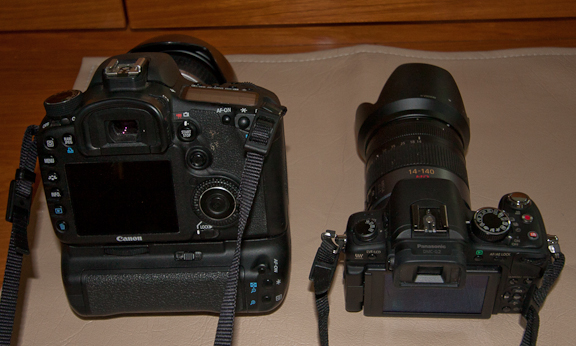
Most photographers who are hardware junkies eventually acquire a small “walk around” camera, something compact to carry when you don’t want the bulk or obtrusiveness of the “real” camera. The problem is that when the big opportunities present themselves the compacts are too slow, don’t have the lower light ability, or other deficits and you miss the shot and vow to always carry the good stuff.
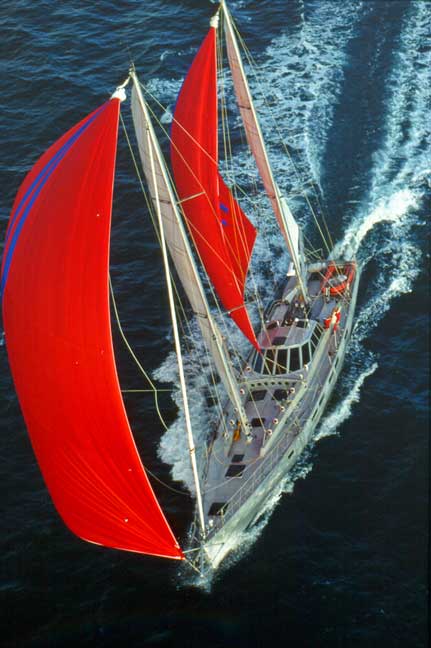
This past week we have been asked three times (by e-mail and in the marina) about the switch from sail to power, and what we thought about it now. Before answering the question some context is in order.
Prior to Wind Horse we had only twice set foot on a stinkpot, both experiences being very short. We loathed power boats, a feeling built up from years of negative interaction. Our sailing yachts, both racing cats in the olden days, and cruising designs more recently, were fast, nimble, and a joy to sail. Beowulf, the 78 foot ketch above and in subsequent photos, was the ultimate high performance cruiser, and crossing oceans aboard her was mostly a pleasure. We enjoyed sailing her agressively as a couple and the challenge of making quick, seamanlike passages, without undo risk, with just two of us aboard, was a big attraction.
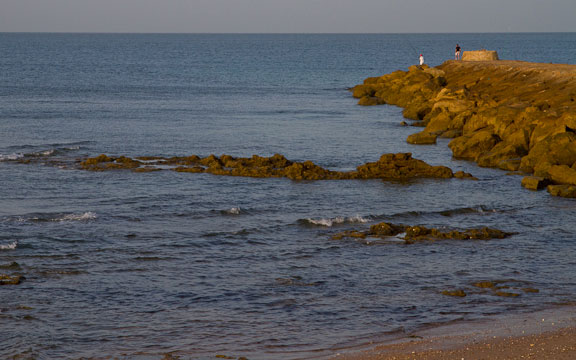
The beaches in Spain and Portugal are very accessible to the general public and get a good workout. We try to get in a walk first thing, before it gets too warm, and this morning after lengthy negotiations it was decided to walk along the beach.
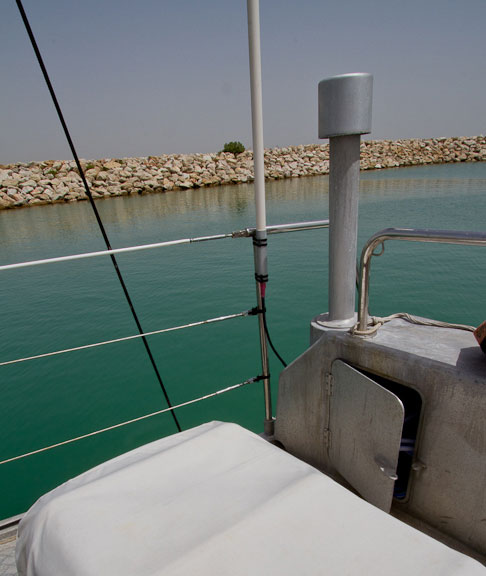
In the photo above we are looking over the life raft. If we needed to launch it in a hurry it would take the two of us lifting it over the lifelines (it weights 125 pounds/60 kg). Which is why the middle and bottom life line are lashed in place.
What do you do all day when you are cruising? It is a question we hear a lot. As we are in Rota, Spain, and have temporarily reached a point of full on “relaxation” mode, we thought some insight into what this entails might be of interest.

To begin with Rota is new to us. So we need to get our bearings.
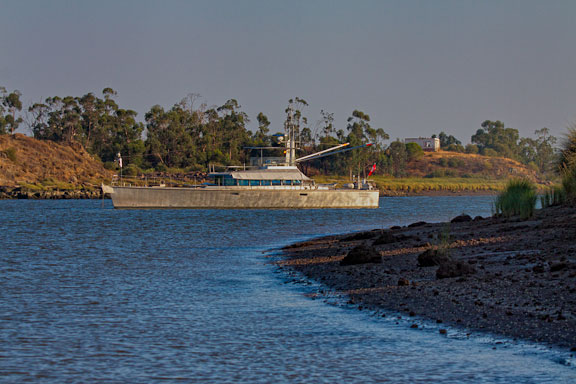
Our recent foray up the Guadiana River was done without benefit of charts. Depths varied from ten to fifty feet (three to fifteen meters) and there was substantial current during parts of the tidal cycle. The current and depth present both navigation and anchoring challenges.
Lets take the nav issues first.
The water injection elbows on the exhausts of Wind Horse’s engines and genset are fitted with temperature sensing bands supplied by AquaAlarm. If these exceed a preset temperature they close a circuit which triggers an alarm. In theory, this is an early warning of salt water flow failure. We are also fitted with sensors on the water flow itself upstream of the engines. None of these devices has ever given us a warning signal.
Our basic rule is to avoid tight harbors and marinas if the breeze is up, unless we know the layout from previous experience. However, our first entry into the marina in Rota, Spain, broke this rule.
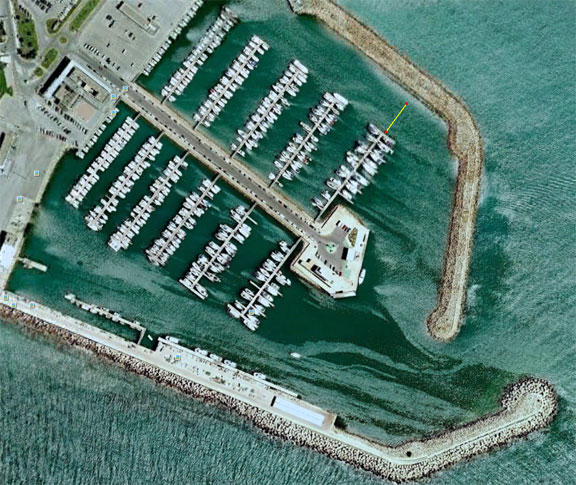
As you can see from the image above, this is a very tight harbor (the yellow line with red dots on the ends is 100 feet/30m long). If it is calm, there is plenty of room to rotate Wind Horse’s 83 feet/25m. But not in a gale.
Hello Dashews,
I was wondering if you have any current weather links. I was poking around
the NOAA website and was continually frustrated while looking for things like
500mb and surface pressure charts. Your website used to have a bunch of
these links but I haven’t been here in a while so I was surprised to see some
of the changes.
Thanks,
Chris
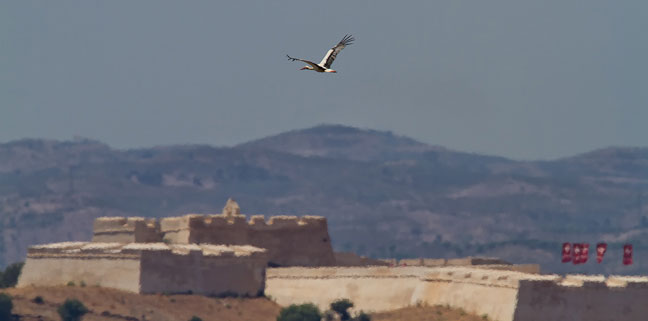
Cruising rule number one: it is often the unheralded destinations that are special. Corollary to cruising rule number one: if you don’t try you will never know.
The Guadiana River, which separates Portugal from Spain, wasn’t even on our radar. Nobody with whom we spoke had visited, and other destinations in the area were more highly touted by the cruising guides. But as our Portuguese Vodaphone Internet system was working, and we needed to stay in touch with New Zealand, it seemed a good bet until we had the Spanish system up and running.
It only took a few hours at anchor, looking at the scenery and wildlife, to know the Guadiana was going to be one of our favorite places.
Circa have sent us some initial fuel burn, speed, and engine loading data for the second FPB 64. This information was collected with the boat at about 80% payload, in light winds, and shallow water of the river that runs into Whangerie.
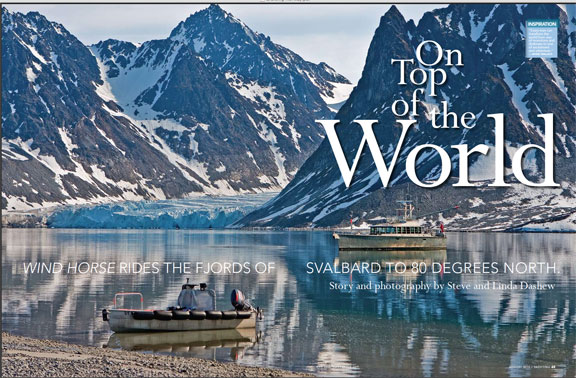
The latest issue of Yachting (USA) has an article by Steve and Linda on their voyage last summer to Svalbard and 80 degrees north.
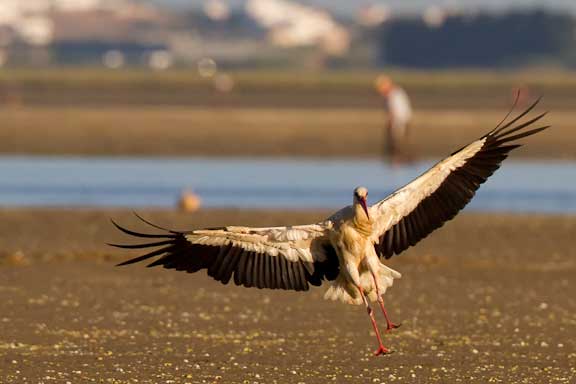
For us to sit in one place for two weeks, especially anchorages as busy as those around Faro and Culatra Island, takes a special draw. Here it is the bird life of the Parque National de Ria Formosa.
There are miles of shoreline and wetlands, with thousands of birds to watch.
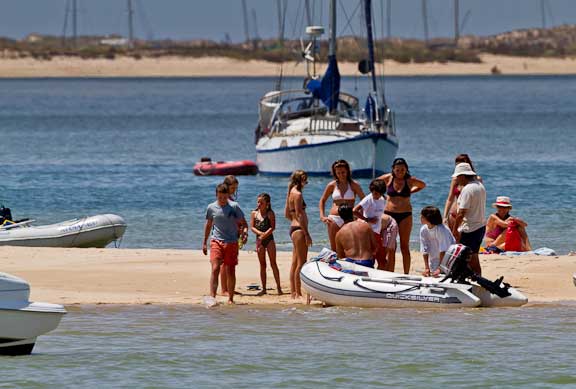
It is a relatively quiet Sunday here in Culatra. The locals and cruisers are mainly at the beach, and we are catching up, trying to forget the pain associated when family leaves after a visit. We’re baking, polishing stainless, doing a little design work, and finally putting together a high res slide show of the area.

We’ve finally figured out how to make some of our photos available as screen savers. There is a test collection now available.
I am interested in knowing about the navigational software the Dashews use? With such a broad mix of cruising locations I am curious if they use one particular piece of software or a combination of several. I think I recall Steve mentioning in the past that he was using Coastal Explorer but I haven’t seen anything mentioned lately.
My second question relates to the blog itself and the photography they post. The system they use to post to their website seems to allow a nice mix of text as well as the flexibility to post varying degrees of picture quality. They seem to be able to post high resolution slideshows which is a very pleasant change. They are in such wonderful, and at times, remote places it is exceedingly enjoyable to be able to see such exceptionally high quality photography. Is there particular blogging software they use which allows this? It seems that most do not have the ability to post the high res photography.
Thanks,
George Laycock
A higher res version of this slide show is here.

Sea trials for the second FPB 64, Sarah-Sarah, are coming along. She now has 25 hours on her engine and she will shortly be ready to turn over to her new owners. So far the punch list is short. We thought a few photos might be of interest.
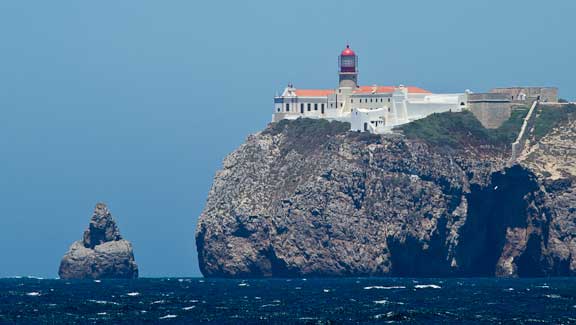
Cape Saint Vincent marks the eastward turn in the coast of Portugal. It also signifies warmer weather, long white beaches, and tourism (just check the advertisements in the travel section of your Sunday newspaper). Given our predilection for cool and quiet we were not sure if this left turn was right for us.
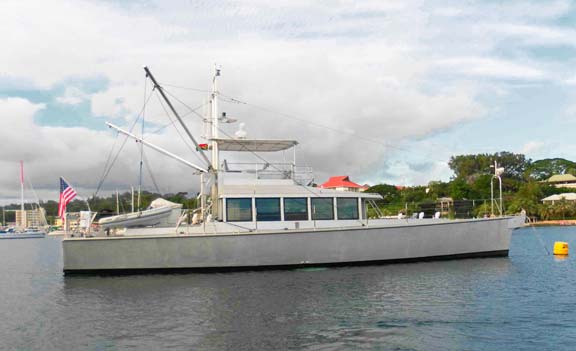
Avatar and crew are now happily basking in the Southern Hemisphere winter warmth of Vila in the island nation of Vanuatu. We sent her skipper, Rod Bradley, a list of questions about the passage which we was kind enough to answer. Rod’s comments provide an interesting look at how the first of the FPB 64 series performs on an ocean passage. Follow Carol and Mike Parker’s adventures with Avatar on their website by clicking here.
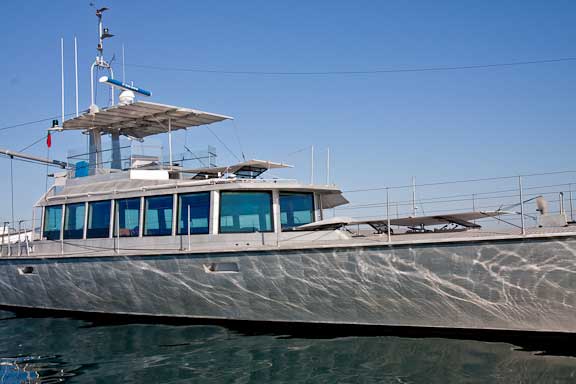
It is getting warmer and our awnings are becoming more important. With the boat head to wind at anchor, and five knots or more of wind, inside temperature during the day is around 82F/28C. Without the awnings things are significantly warmer! Ideally you detail the deck with awnings in mind during the design phase. Our goals are as follows:
Steve,
The Bayfield 32 I recently bought has old Mariner furling units on both the head sail and the stay sail. These allow easy (relatively) changes of sail configuration as they allow hanked-on sails. I know that you had used and recommended these units in the past and I was wondering if you still had praise for them? What if any trade-offs am I making if I keep them? It seems to me that they might have issues as stay tension is increased. They seem to work, but as I’m a new sailor and this is my first sailboat, I have nothing to compare them to. Thanks
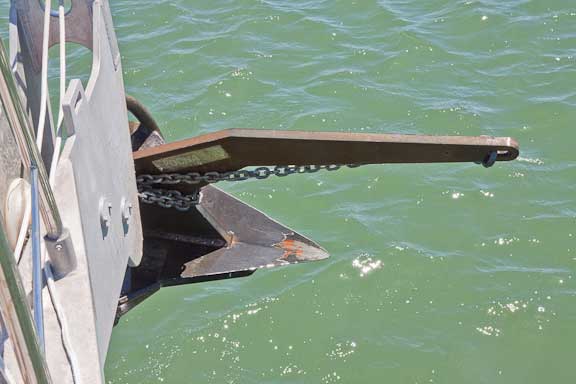
Here is an unusual but significant reason to use an oversized anchor. We’ve been anchoring in tidal estuaries with lots of reversing current. When we picked up the hook to move yesterday it came up with the chain wrapped three times around the stock. That means under load the pull on the anchor was not as designed, reducing the holding power. But this anchor is so much larger than suggested that it still has plenty of muscle.
Clearing a foul like this is not difficult. Here are the steps we used:
If you are just joining us, and are looking at the FPB64 Avatar Final Trial photos for the first time, we suggest you take these blogs in order. You will find at the end of each blog a link to our high res photo server which will allow you to view these remarkable photos full screen.
Links for the three articles, in order, are below.
Part one is here.
Part two will be found here.
Part three is here.
For the associated slide shows, with versions of the photos that will play full screen, see the links below.
Part one slide show is here.
Part two slide show is here.
Part three slide show is here.
![]()
Since launching we’ve had master aerial photographer Ivor Wilkins on standby for the right conditions to shoot the first FPB 64. The day before Avatar was due to depart for Vila in Vanuatu the appropriate wind and sea state arrived. The photos which follow (with a link at the end to high res versions) were taken in post severe depression conditions.
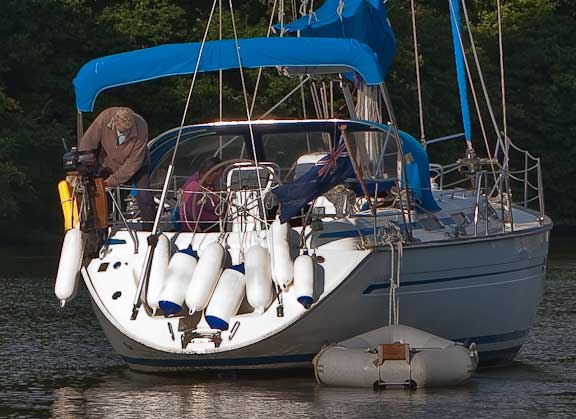
Cruising in this part of the world means you will often be rafting or docking stern to both with neighbors on both sides. This requires lots of fenders. Read the rest »
![]()
While the first set of Final Trial photos represented the worst of the conditions, in the real world, even in gale force winds, you don’t encounter an unending succession of such seas. This next set of photos, taken during the same shoot, represent more of a norm. We’ll start with downwind, since that is clearly the most fun.
![]()
We’ve now received a few selected images from Ivor Wilkins in high resolution (the source files are 60mb each!), so we are able to crop in really tight and dissect what is going on. We’ll start with this shot and look at the bow and stern a little closer (if you are just joining us there are two preceding blogs which should be read first. At the end of each is a link to a slide show that will allow you to study these photos full screen).
Steve,
Just thought I would drop you a note of thanks. Followed your websites for years, read many of your publications, including Surviving the Storm.
I don’t remember where, but you wrote something to the effect of: “I spent too much time accumulating the wealth I thought was necessary… go sooner, with less.”
Of all the compelling advice you have, that’s the line that’s ringing in my ears as I hand off our growing business, sell our home and take our 7, 9 and 11 year olds aboard for an indefinite period.
Thank you.
Peter & Lisa
s/v Day Dreamer
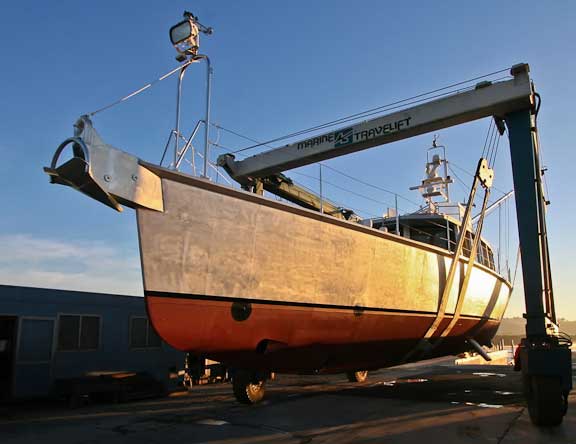
A lovely photo taken by Ed Firth of Circa, showing what every owner, builder, and designer looks forward to – launch day. This is Sarah-Sarah, the second FPB 64, destined shortly for a trip from New Zealand to the Pacific Northwest, on her own bottom of course.
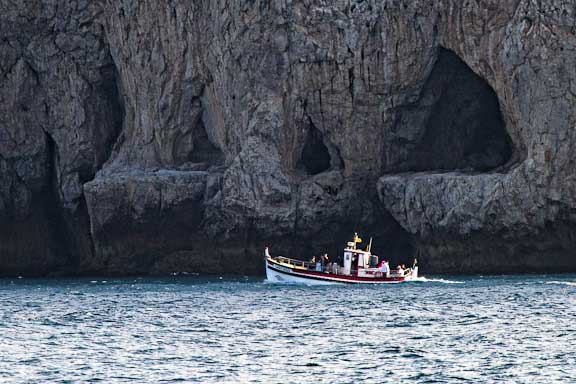
Yesterday we realized by this time last year we’d been to Svalbard, touched 80 degrees north, and were on our way back to Tromso, Norway. So we determined to set out on an adventure to see if our anchor still worked after a week of marina living, while checking out a quaint Portuguese fishing village we’d heard about at the same time.
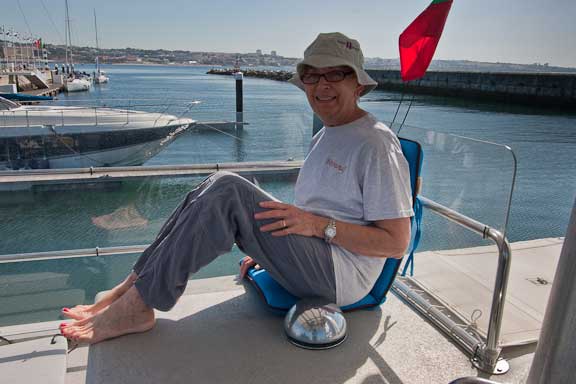
A few odds and ends to share. We call this the Raven seat. During sea trials on the FPB 64, Avatar, a legacy from the Owner’s previous yacht was put to good use. When we found something similar in the local Jumbo supermarket we determined to test it on Wind Horse. It worked so well we now have two, and at ten Euros each we can dispose of these when they get nasty looking.
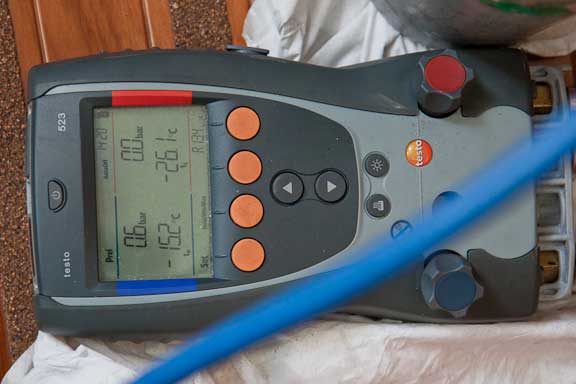
We have had zero problems with our Frigoboat sealed compressors, three of which are in use with our two freezers and one fridge. But after five years the fridge had lost a touch of refrigerant and was running more than normal. We carry 134A and a charging system for this eventuality, but in the process of adding refrigerant we allowed air into the system. The result was a frozen evaporator system requiring a vacuum pump. This was at 1400 on a Friday afternoon in Spain. What do you think of the odds?
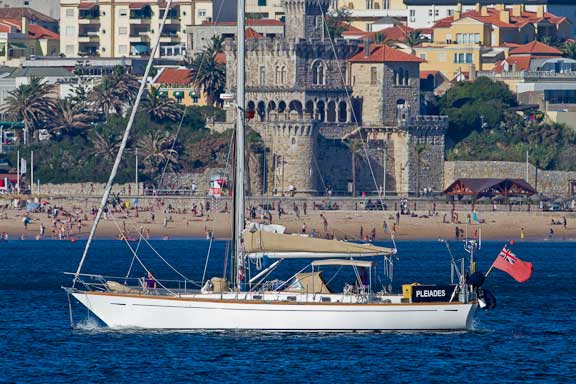
We had heard all sorts of comments about Portugal and its inhabitants. They were said to be morose, unapproachable, difficult with which to interact. This is definitely not the situation. From the moment you first meet the Marina Cascais crew, and are given a welcome bottle of Portuguese wine, to the last cab driver, we have found the locals to be friendly, eager to help and after a period of introduction, as interested in us as we are in them.
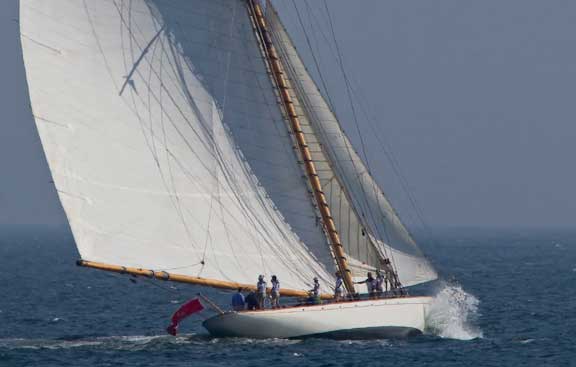
We were walking back from the train station to the marina (this area has wonderful public transport) and noticed MoonBeam lV off in the distance leaving the harbor. By the time we were back aboard she was well offshore, but a 400mm lens and a shooting position on the radar platform brought her into detail.
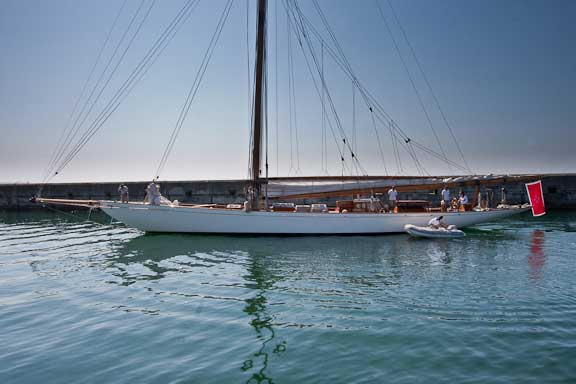
Now here is a treat for you. You are looking at the beautifully restored 1915 gaff cutter MoonBeam lV. She is a Wliiam Fife design of roughly 100 feet (30m). In this photo she is heading to the fuel dock. Last night,when she came in, it was blowing 30 knots down the very narrow marina channel and the crew had to make a right angle turn to get into the slip nearby. You have to be both good and oblivious to the results of mistakes when handling such a lovely large old timer in windy and crowded conditions.
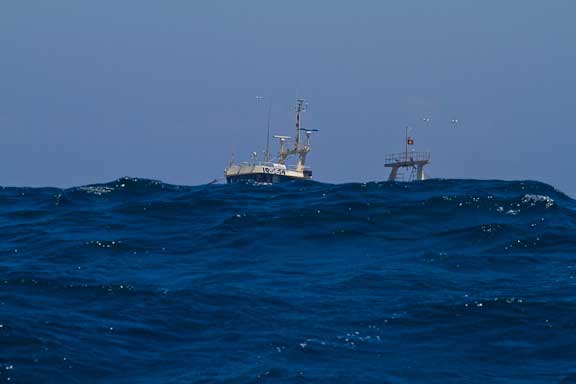
We’ve just had a lovely run down the coast from Vigo, Spain to Cascais, Portugal. Twenty one and a half hours for 240 NM at reduced revs, with some great surfing thrown in. But the most important aspect of the trip was reminder of why we design as we do. The photos which follow were taken on an average day with the “Portuguese Trades” blowing, courtesy of the Azores high. The wind is in the 25 knot range, not that strong, yet combine its waves with swells from a force eight gale nine hundred miles away and it is enough to generate waves which essentially bury a very large trawler from our view standing on the deck of Wind Horse.

One of the great pleasures in cruising is observing wildlife, both exotic as in polar bears and whales, and common, like the various types of gulls. Seagulls are amazing flying machines and very adept soaring pilots. Not the most aesthetic of birds at rest, they are exquisite in flight, reminiscent of the high performance gliders we have flown.

Part of the cruising experience is occasionally renting a car, getting off the boat, and visiting the countryside. If you are in Galacia at the top of the list is a pilgrimage to Santiago de Compostella, one of the three most visited sites in Christendom. For us, this was more about the journey through some of the interior, and people watching, than visiting a shrine, although the latter has its allure as well. We are hesitant to write this up as pure travelblogs are boring to us, but this one is hard to resist.
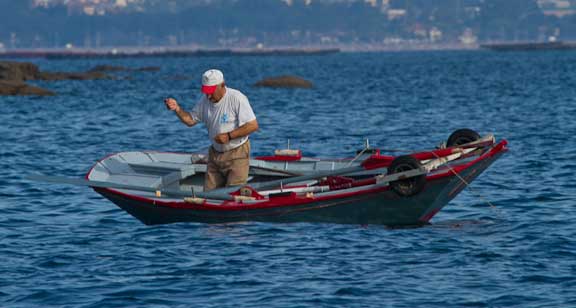
We are always interested in the local commercial boats. Design wise, there are often lessons to be learned. The Galacian Rias have an ongoing commercial fishery, with small craft and large. The punt design above seems to be common for local fishing.
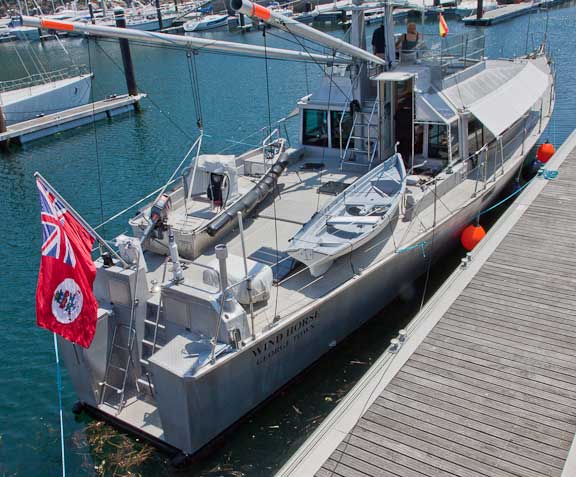
Astute readers of this blog will no doubt have noted by now the absence of the rust stain on Wind Horse’s aft starboard quarter. The rust stain was a continuing nuisance, courtesy of a not so “stainless” steel smokestack on our Kabola diesel heater (now replaced in non-staining aluminum). The rust stain removal took a half an hour.
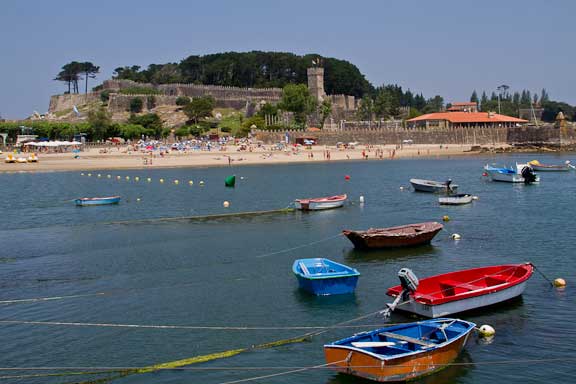
The Ria de Vigo is a study in contrasts, and a reminder to us of what makes cruising in the more developed world interesting. Take the lead photo, of Baiona, Spain (that’s the Galacian spelling, the Spanish spell it Bayonna). The enormous fort in the background dates to the 11th century. The red tiled roof to the right is the Montereal Club de Yates, a three time challenger for the America’s cup, contained within the fort complex.
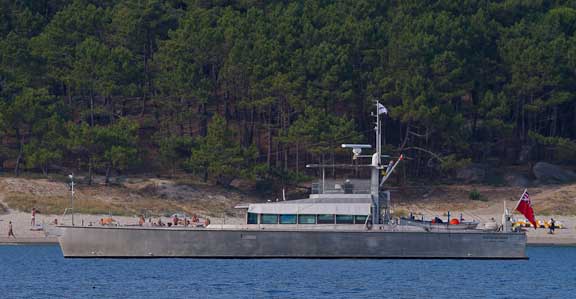
It is now officially warm, we are using our awnings, and even running the air conditioning on occasion. All of which brings to mind the subject of air con capacity. If you are going to have a air conditioning, and it is very nice in some situations, it needs to be looked at in an overall systems context. Typically the major power consumer aboard, if designed without thought for overall efficiency, the penalties can be substantial. The industry norm is to maximize capacity, for the worst possible situation, and then run the air on a low duty cycle. This forces you into big generators because of starting and running loads, which are loafing (bad) when the air is not running.
We think there is a better way.
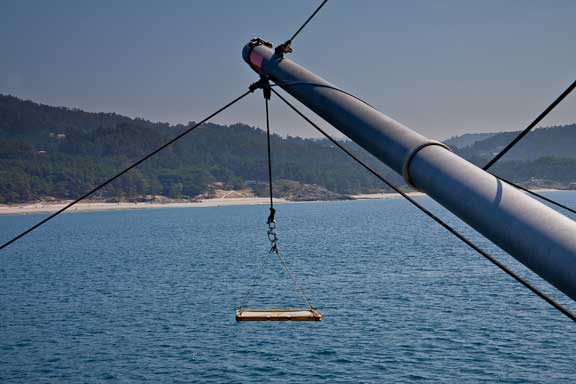
We’re told open roadsteads, with bouncy sea-states, are not unusual from here on out. For most yachts it can get down right uncomfortable when the wind is at right angles to the chop. Wind Horse is very stable with ocean swells coming into the anchorage. They barely move her. But the short period chop from ferries and dinghies are another story. Which is one of the reasons for her big booms.
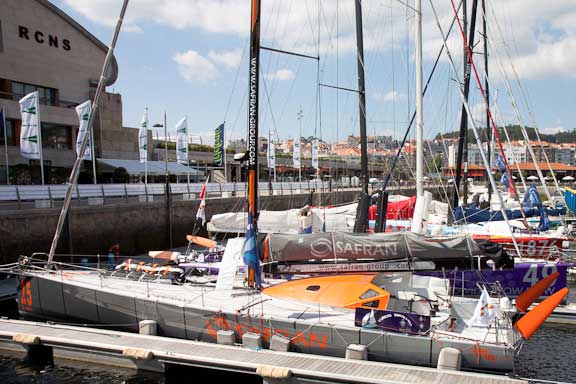
For those of you who are really hard core we offer a slide show of the open 60 rigging and hull shape details. These are the ultimate sailing machines, designed to be raced around the world single-handed. When viewing these slides keep in mind that you can control the progress of them with the +/- buttons (or let the show play automatically) and view full screen images by clicking on the box in the bottom right hand corner of the screen.
Click here for the Open 60 details.

We’re in the land of Med mooring (stern to) and most yachts have some form of stern gang plank system. Many are elaborate, others more like a plank of wood. This is the first time we have seen a gangplank also used as a dinghy launching system.
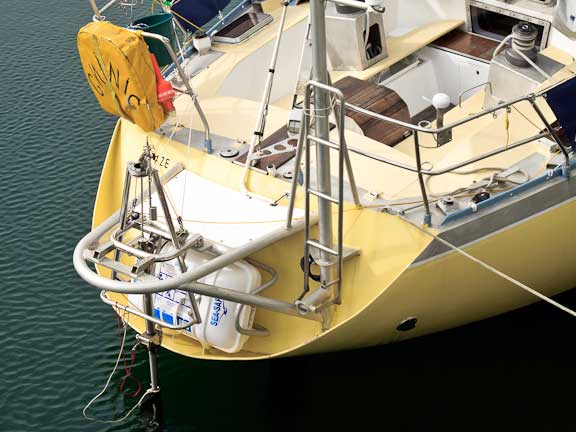
Several interesting details to comment on with this aluminum French yacht.
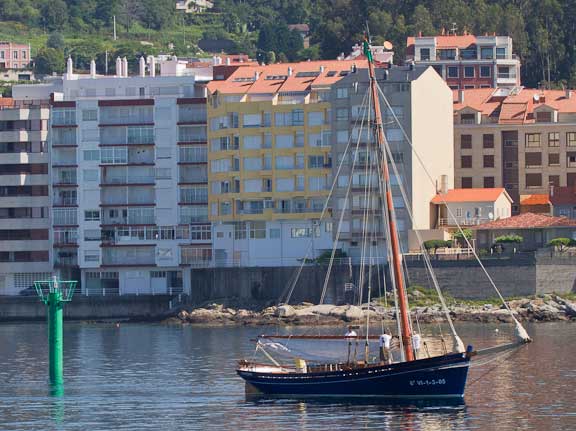
Between Open 60 racing and various Spanish festivals, we have been seeing some interesting craft the past few weeks. We love the modern designs of course, but the functionality of the traditionals also has a certain appeal – and perhaps a lesson or two.
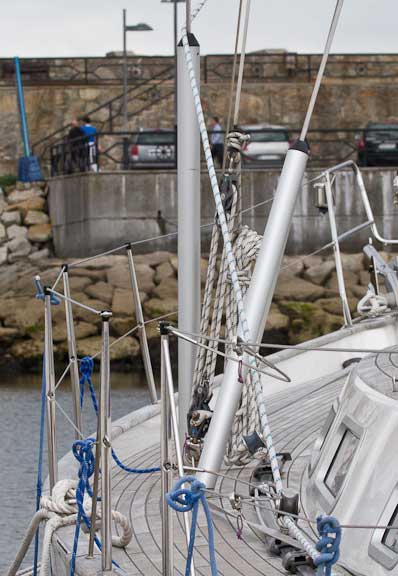
Here is an idea we have never understood, placing tubing over the bottom end of rigging.The concept is to eliminate chafe and provide a surface which facilitates the movement of sails and sheets when tacking. However there are several problems with this approach.
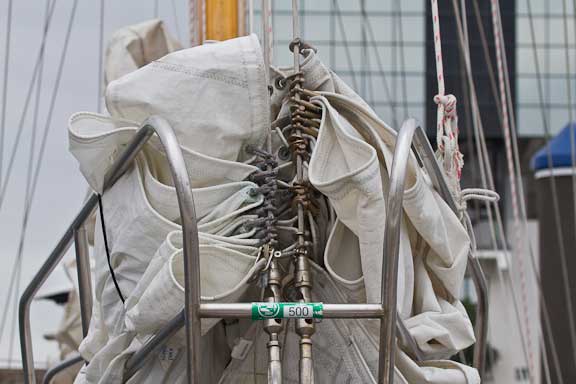
Here is a historic detail on a 30 year old home built ketch just back from a cruise to the US. She is still owned and sailed by her designers/builders, a vigorous couple. There are advantages and disadvantages to side by side twin stays.

We are always on the watch for cockpit awning ideas. Here are a couple of good ones. The cockpit awning system above has several things going for it:
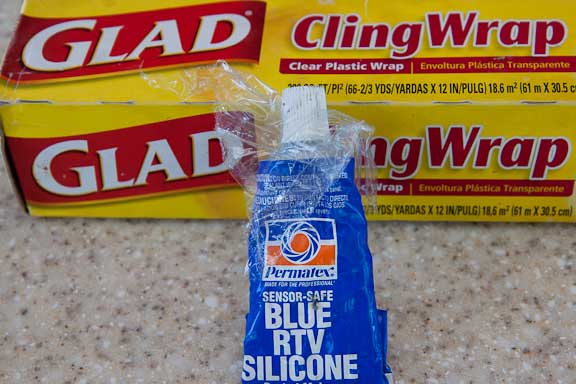
You are looking at a three year old tube of silicone which is still soft and uncured. The secret? A seal of cling wrap (also known as Saran Wrap). Simply tear off a small piece, place it over the threaded tube end, and screw the cap back down. The seal this makes prevents moisture from getting to, and hardening, the silicone.
Permatex “RTV” gasket silicone is a must for the engine spares. It is often used in place of paper gaskets, and works well at high temperatures.
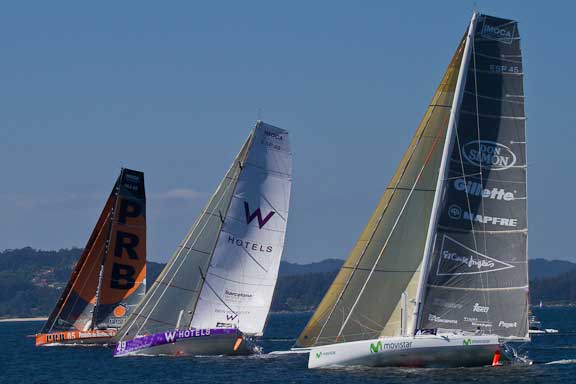
Having talked with our offspring and father (who is at Catalina this weekend going strong at 94), had pancakes for breakfast, and t hen enjoyed a relaxed morning, what could be possibly added? Perhaps a bit of open 60 racing off the stern would be nice. These are astonishing boats. Hugely powerful with canting keels, light – less than 10 tons – with rigs limited to 105 feet (31 meters) – and designed to be sailed by a single hander.
Can you imagine working this machinery in the bay, let alone the Southern Ocean? By coincidence we turned up in Sanxenso, Spain the night before they were due to leave for the next stop in an around Spain race (this one crewed). So, before returning to the drawing board, we took a detour and followed the Open 60s as they reached back and forth and then set kites for their run south.
The photos in the side show in the link below were taken mostly in less than eight knots of wind. Wind Horse was cruising at 11.5 at and barely able to keep up.
Click here for our Father’s day present.
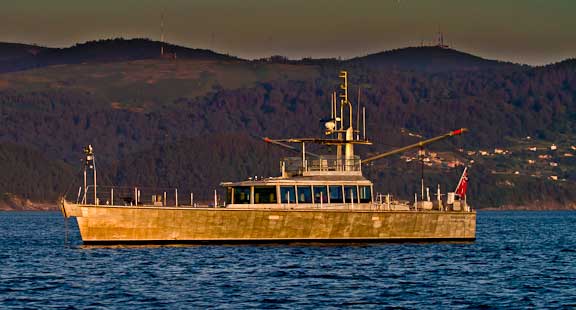
We’re anchored off the beach at Sanxenxo. This is an open roadstead, exposed to the Atlantic from the south, which right now is quiet. There is a long period small swell sweeping in which does not affect us. But the shorter period power boat wakes, of which there are a multitude, excite our hull. Hence the booms are deployed with flopper stoppers for the first time in two years.
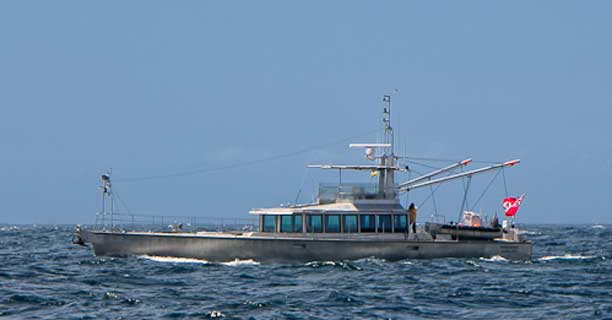
We have finally found a windless day with flat seas in which to test our new props. What we know so far is that at a little over full payload we can achieve 2400RPM at wide open throttle. Our original target was 10.5 knots at 1600 RPM, at three quarters payload. Lets see how we did on the calculations:
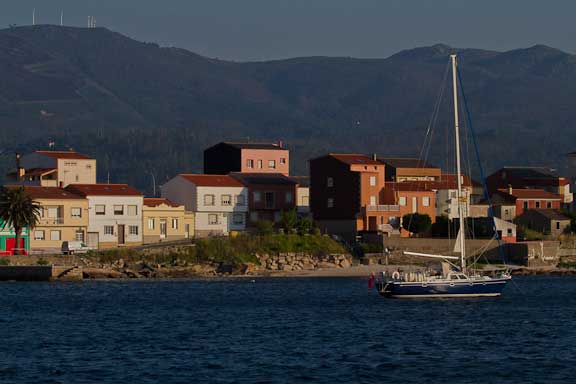
We’ve been exploring the Rias (river estuaries) of Galicia. They are an interesting mix of frenetic development, and traditional Galacian architecture. There are marinas everywhere, but we have been able to find pleasant places to lie on our own hook. The food is wonderful, and we have enjoyed our limited dialog with the locals (our spanish is in need of some fine tuning).
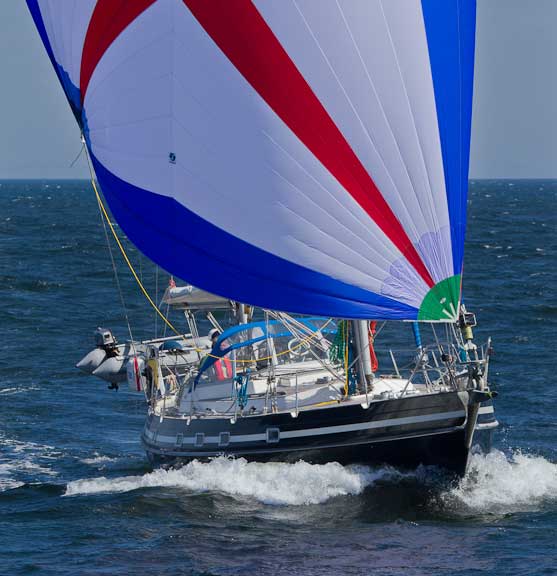
We offer the photo above as proof that you don’t need the latest and greatest to enjoy cruising. This is a 30 year old Compass 48 owned by a Dutch couple we recently met. They are surfing along in a fresh northerly, having a wonderful sail. But what happens when the wind goes forward and the two of them need to douse the chute?
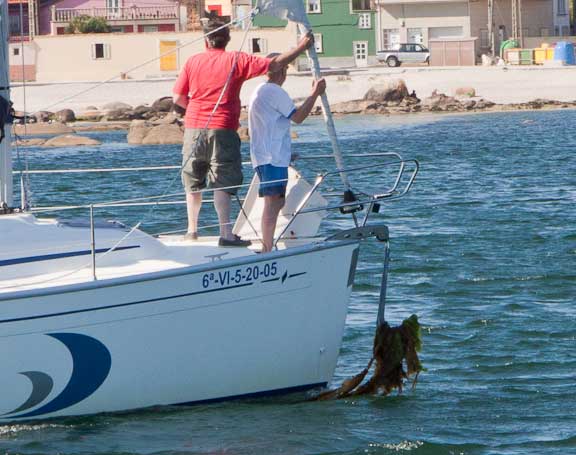
Cruising in the old world means lots of interesting boat watching, the best of which is usually provided by the charter fleets. Two of these yachts joined us and tried to anchor on a bottom that had a nice growth of kelp, which you can see on their anchor. The two boats spent an hour trying to get a good bite, then retired to a nearby marina. The answer to their dilemma is easy. More scope. If you normally set the hook with a scope of five to one, use six or seven if the anchor gives indication of not digging in. Then, once you have backed down on the hook under power and confirm it is well dug in, winch back the extra chain.
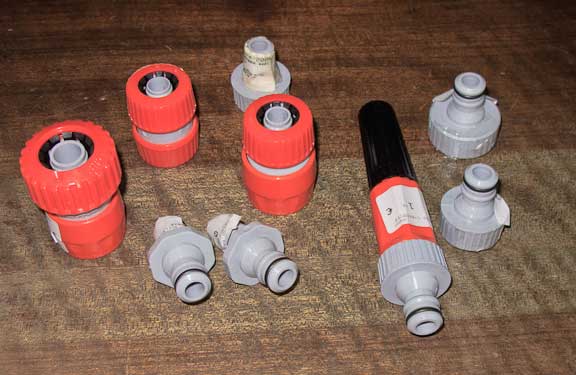
We’ve been making do connecting our water hose with a leaky collection of fittings for the past five years. So when we purchased 100 feet (30m) of light weight and soft hose last week we decided it was time to upgrade the hose fitting inventory. In this part of the world quick disconnect is the way to go. The nine Euro/twelve Dollar collection you see above allows us to join 15 and 19mm hoses together, connect sections of hose with quick disconnect fittings, or thread two onto two sizes of hose bibs. This is neater, simpler, and cleaner than the old fashioned fittings with hose clamps we have been using.
We have just spent three days at anchor. For at least eight hours a day the portable computer and the desk top Imac with its second monitor and three exteral hard drives have been in use. There are two freezers going, a big fridge, and we are cooking electrically. We also don’t overly concern ourselves with power consumption for lights.
The amp hour meter says 930 amps or 310 amps per day average (at 24 volts), and the battery capacity is listed as 50%. If we were to sit another day we’d probably run the genset tonight to do a little battery charging. But as we are moving 38 miles, the engines will do a pretty good job of charging while we are under way.
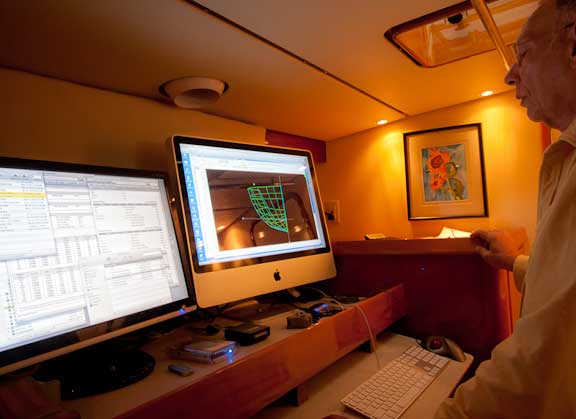
It is so easy to take your work with you when cruising these days. Good communications – right now we have a Vodaphone 3G connection – make it very efficient. If you are computer dependent as we are, having an office afloat is simple. We run our Windows based engineering programs on the Mac we use for photos and video editing. But is this a cruising combination good idea?
Steve,
I am curious about your navigational software. I seem to recall in previous posts on your blog that you mentioned Coastal Explorer and I wondered if that was your primary software or a backup program you were using.
If purchasing navigational software today for the type of cruising you have been doing what product would you select? I don’t recall that you have mentioned that lately.
Thanks,
George Laycock
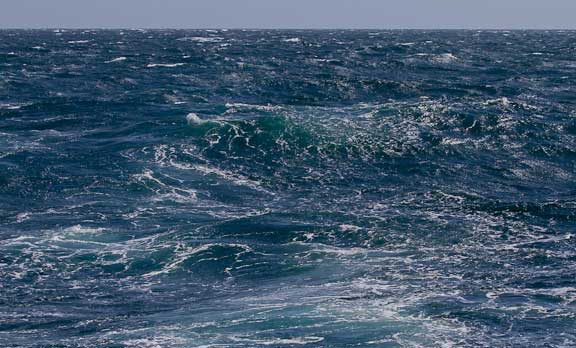
For the last 2000 years the coast between A Coruna and Cabo Finisterre has had a bad reputation. Frequent fog, a lee shore, off lying rocks, and gradient onshore winds accelerated with a thermal sea breeze, have claimed thousands of lives. Really we are not kidding about this. But on the other hand, if you like to surfing, are headed towards the equator, and the Portuguese trade winds are blowing, this is the place. It is also a good location to practice wave photography, and ponder why the camera always makes the waves look smaller.
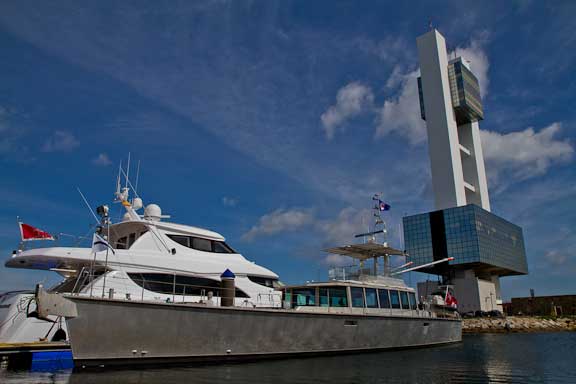
A bit of false advertising with this sunny day in Marina Coruna – just one of these in the week we have been here. Otherwise, rain and wind, which is OK as we have been catching up on various business related paperwork and doing a little designing, all made easier with a stable wifi connection. We have also had a chance to meet a bunch of cruisers, some returning from the States, a few going to the West Indies, most headed south to the Med.
The following question was posed by the Owner of FPB 64 #3. We thought the technical minded amongst you might have some helpful suggestions.
“We are building a new boat and intend to put a WiFi signal booster on board for routine in port use. In addition, for offshore, we intend to install a Fleet Broadband 150 satellite phone and internet system. As part of the process
Hi Steve,
One question … when and how did you get started with boat design …and so on …? Maybe you should publish a short bio on your website … I am sure I am not the only one asking you.
mit freundlichem Gruss / with kind Regards,
Sebastian Linnert
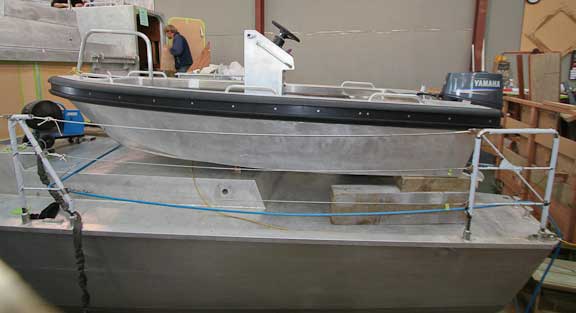
Circa have been working with several of the FPB 64 Owners to come up with what they all think is an efficient, long lasting cruising tool. The first of these is show above sitting above ready for its chocks to be patterned.
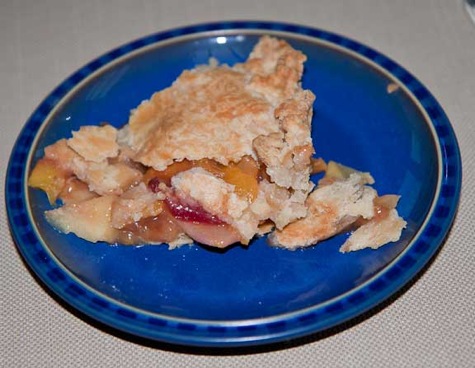
We continue to be impressed with our Panasonic NN-CF778S combination oven. Capable of using microwave, convection, and broiling to the same dish, automatically if desired, it is also working well in a straight baking (convection) mode, as attested to by the photo above from last night.
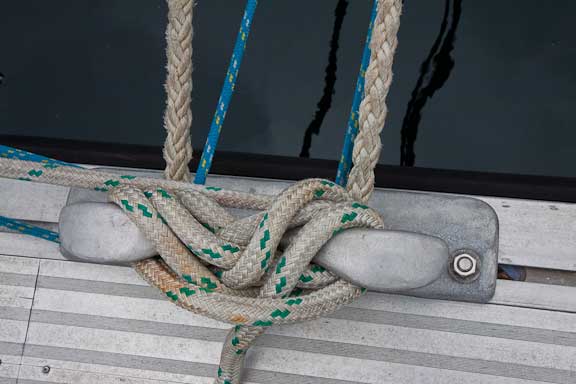
The yacht basin at Marina Coruna is a little bouncy with northerly quadrant winds. We and everyone else are surging against our dock lines. There are comfort issues with jerking and noise which we have solved with a combination of dock line materials.
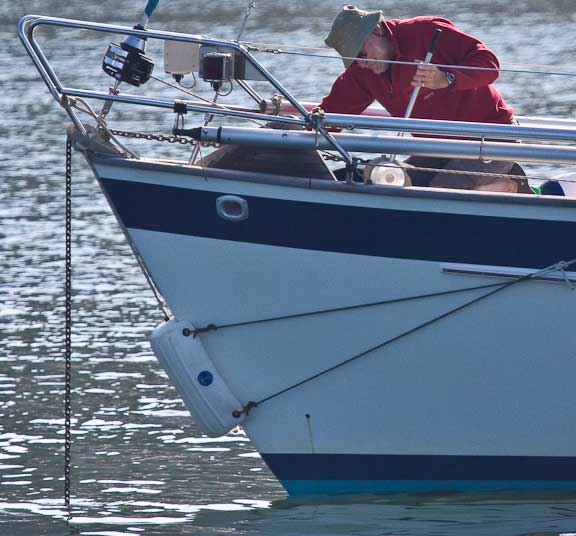
When we first started cruising we were urged by those in the know to get a powered windlass. We resisted for a short period, but quickly became believers in electric as opposed to hand power.
There are multiple reasons for this:
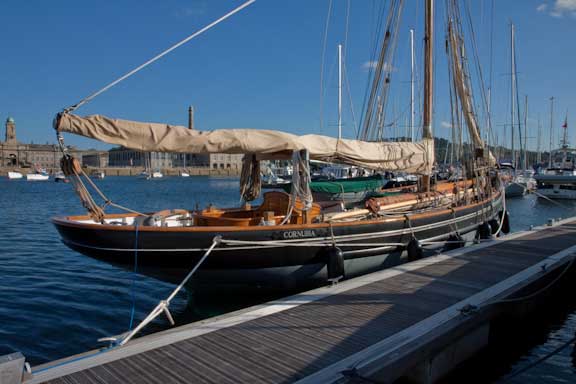
Here is a rare treat, a 99 year old English pilot cutter, now lovingly restored as a yacht. We noticed Cornubia when we were walking the docks in Plymouth. Over the years we have seen many designs that claimed to be based on the pilot cutter concept but most had concessions to the world of yachting. So when we found out this was the real deal we looked a lot closer.
Hi Steve & Linda,
Would you explain what kind of transmission allowed you to pack your engine into the aft ER like you did?
Regards,
Bob Frenier